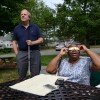On a recent drive to Brookline, relishing what was probably the last of the summer-like weather, I enjoyed an all too rare moment: a chance to pause and appreciate the beauty of nature.
I made my way down a much-traveled thoroughfare, passing postcard-pretty, tree-lined streets. I was headed to a socially distanced patio meeting with a dear friend who happens to live in one of the suburb’s most leafy havens. I turned onto my friend’s street and slowed to admire the abundance and variety of the trees fronting each of the lovely large houses. No, green-thumb me didn’t know the names of all the species, but I later learned that the verdant beauties — some tall, some wide, and some slim — included spruce, white pine, and maple. Fun fact: the tree inventory maintained by Brookline Parks and Open Spaces documents well over 50 varieties of trees on Brookline streets.
Whatever their species, most of the trees on my friend’s street were planted ages ago, their thick trunks and deep roots evidence of their long history — just like the mature oaks, maples and lindens which line Melnea Cass Boulevard, a wide thoroughfare which stretches from the Massachusetts Avenue Connector to the Ruggles MBTA station.
Six hundred trees were embedded there 39 years ago. The trees, sturdy sentinels, protect the Roxbury neighborhood from the punishing heat of the sun’s reflection off asphalt streets. Unlike Brookline or other Greater Boston neighborhoods where trees are more plentiful, this urban neighborhood does not have as much of what’s called “tree canopy,” or shaded areas. Tree canopy is even more precious in Roxbury, one of Boston’s “heat islands.”
But 120 of the trees were originally marked for cutting as part of Boston’s 2011 redesign to widen the four-lane street and add a bike path. Residents have continued to oppose the plan, but recent news that the trees had actually been marked and scheduled for cutting spurred renewed attention and expanded the voices of opposition.
Designed to manage the increasingly heavy traffic and improve safety for pedestrians, the plan also includes planting 205 new trees to replace the older ones. But it’s older trees which are best equipped to protect against environmental damage, combatting flooding and cooling oppressive heat. Tomiqua Williams of the group Friends of Melnea Cass Boulevard told the website E&E News for energy and environment professionals, “The city knows we are hotter than everywhere else. ... You are silently killing us.”
These days, most Americans accept climate change’s damaging impact on the environment. Roxbury residents should not be forced into the lose-lose choice of either a safe street or a shaded area.
Maybe they won’t be. Opposition from several Boston City Councilors — led by City Council President Kim Janey — and the attorney general’s office pushed the city to “pause” the project to allow for further review.
At least the treasured trees lining Melnea Cass will remain where they are for now, their thick-bodied trunks aging into majestic beauty. Money mogul Warren Buffet once mused, “Someone’s sitting in the shade today because someone planted a tree a long time ago.”
Roxbury residents’ fight to protect the shade for future generations is more than a worthy cause. It’s environmental justice.





